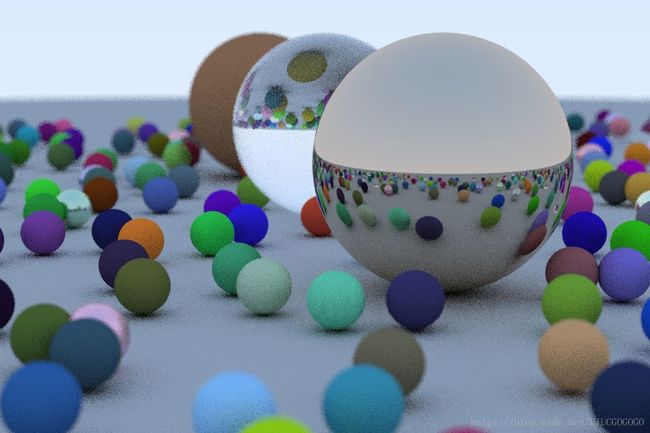#include"vector.h"
#include"ray.h"
#include"sphere.h"
#include"hitable_list.h"
#include"camera.h"
#include"material.h"
#include"random.h"
#include
#include
#include
#include
#include
using namespace std;
//此处的world就是把整个场景里的所有object视为一体(即hitable_list)
//depth是ray的传播深度,scatter一次加一
vec3 color(const ray& r,hitable *world,int depth)
{
hit_record rec;
//如果viewing ray(反向光线)与hitable object相交
//tmin采用0.001是基于对showdow的考量,见fundamentals p86
//然而当前还没有引入light,阴影部分是因为当光线到达此处时经历了太多次反射
if (world->hit(r, 0.001, FLT_MAX, rec))
{
//当前还不能确定是difusse还是reflection,取决于hitable的material
ray scattered;
vec3 attenuation;//削弱
//如果scatter次数小于50
//并且ray接触的hitable object的material能成功调用scattered函数
if (depth < 50 && rec.mat_ptr->scatter(r, rec, attenuation, scattered))
{
return attenuation*color(scattered, world, depth + 1);
}
else//scatter超过50次,能量全被吸完了;scattered函数调用失败
{
return vec3(0, 0, 0);//黑
}
}
else//注意当前还是没有引入light,依然是由最后一条ray的direction的y值决定color
//实际上可以认为是background在发光
{
vec3 unit_direction = unit_vector(r.direction());//得到单位方向向量,将y限定在-1至1之间
float t = 0.5*(unit_direction.y() + 1.0);//间接用t代表y,将其限制在0至1之间
return (1.0 - t)*vec3(1.0, 1.0, 1.0) + t*vec3(0.5, 0.7, 1.0);
//所谓插值法,不同的ray对应的t不同,这些t决定了其对应的color为(1.0,1.0,1.0)和(0.5,0.7,1.0)之间某一RGB颜色
//RGB各分量实际就是一个介于0.0至1.0的小数
}
}
hitable *random_scene() {
int n = 500;
hitable **list = new hitable*[n + 1];
list[0] = new sphere(vec3(0, -1000, 0), 1000, new lambertian(vec3(0.5, 0.5, 0.5)));
int i = 1;
for (int a = -11; a < 11; a++) {
for (int b = -11; b < 11; b++) {
float choose_mat = drand48();
vec3 center(a + 0.9*drand48(), 0.2, b + 0.9*drand48());
if ((center - vec3(4, 0.2, 0)).length() > 0.9) {
if (choose_mat < 0.8) { // diffuse
list[i++] = new sphere(center, 0.2, new lambertian(vec3(drand48()*drand48(), drand48()*drand48(), drand48()*drand48())));
}
else if (choose_mat < 0.95) { // metal
list[i++] = new sphere(center, 0.2,
new metal(vec3(0.5*(1 + drand48()), 0.5*(1 + drand48()), 0.5*(1 + drand48())), 0.5*drand48()));
}
else { // glass
list[i++] = new sphere(center, 0.2, new dielectric(1.5));
}
}
}
}
list[i++] = new sphere(vec3(0, 1, 0), 1.0, new dielectric(1.5));
list[i++] = new sphere(vec3(-4, 1, 0), 1.0, new lambertian(vec3(0.4, 0.2, 0.1)));
list[i++] = new sphere(vec3(4, 1, 0), 1.0, new metal(vec3(0.7, 0.6, 0.5), 0.0));
return new hitable_list(list, i);
}
int main()
{
int nx = 1200;//200列
int ny = 800;//100行
int ns = 10;
ofstream out("d:\\theFirstPpm.txt");
out << "P3\n" << nx << " " << ny << "\n255" << endl;
hitable *list[5];
float R = cos(M_PI / 4);
list[0] = new sphere(vec3(0, 0, -1), 0.5, new lambertian(vec3(0.1, 0.2, 0.5)));
list[1] = new sphere(vec3(0, -100.5, -1), 100, new lambertian(vec3(0.8, 0.8, 0.0)));
list[2] = new sphere(vec3(1, 0, -1), 0.5, new metal(vec3(0.8, 0.6, 0.2), 0.0));
list[3] = new sphere(vec3(-1, 0, -1), 0.5, new dielectric(1.5));
list[4] = new sphere(vec3(-1, 0, -1), -0.45, new dielectric(1.5));
hitable *world = new hitable_list(list, 5);
world = random_scene();
vec3 lookfrom(13, 2, 3);
vec3 lookat(0, 0, 0);
float dist_to_focus = 10.0;//焦距
float aperture = 0.1;
camera cam(lookfrom,lookat,vec3(0,1,0),20,float(nx)/float(ny),aperture,dist_to_focus);
for (int j = ny - 1;j >= 0;j--)//行从上到下
{
for (int i = 0;i < nx;i++)//列从左到右
{
vec3 col(0, 0, 0);
for (int s = 0;s < ns;s++)
{
float u = float(i + drand48()) / float(nx);
float v = float(j + drand48()) / float(ny);
ray r = cam.get_ray(u, v);
vec3 p = r.point_at_parameter(2.0);
col += color(r,world,0);
}
col /= float(ns);
//进行gamma校正,一般来说取gamma=2,原理及公式见fundamentals p63
col = vec3(sqrt(col[0]), sqrt(col[1]), sqrt(col[2]));
int ir = int(255.99*col[0]);
int ig = int(255.99*col[1]);
int ib = int(255.99*col[2]);
out << ir << " " << ig << " " << ib << endl;
}
}
return 0;
}

